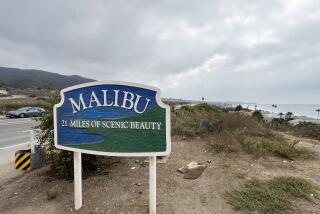‘Superquake’ May Lie Ahead Almost Anywhere in U.S.
- Share via
The horror that rocked Alaska 25 years ago inevitably will happen again somewhere, as huge plates of the Earth’s crust regularly slip and produce monstrous earthquakes.
“There’s absolute certainty a great quake will hit Earth somewhere every few years, and almost as much certainty that every 20 to 30 years we’ll have one of the supergiant quakes, as in Chile in 1960 and Alaska in 1964,” said John Nance, author of “On Shaky Ground: An Invitation to Disaster.”
In the United States, Alaska and perhaps the Pacific Northwest are most prone to superquakes, but California and the eastern half of the United States have trembled violently in somewhat smaller temblors--and will do so again.
“It’s dangerous arrogance for any of us, wherever we live, to assume the problem is isolated to any particular region,” Nance said by telephone from Tacoma, Wash. “We stand united in the shadow of seismic peril.”
The quake that shook south-central Alaska on March 27, 1964, measured 8.5 on the Richter scale and 9.2 on the “moment magnitude” scale, which seismologists say is the most accurate measure of large temblors.
Rare ‘Supergiant’ Quake
That makes it the second-largest quake ever recorded, and one of only three “supergiant” quakes this century.
The largest was of magnitude 9.5 on May 21, 1960. It generated a tidal wave that killed 5,700 people in Chile. The third superquake was of magnitude 9.0 on April 11, 1952, on the Kamchatka Peninsula of the Soviet Union.
Alaska’s giant quake relieved so much underground stress that a repeat in the same location is unlikely for 300 to 1,200 years, said Christopher Stevens, a U.S. Geological Survey seismologist in Menlo Park, Calif.
A less powerful but still dangerous quake could hit the same area much sooner, said USGS seismologist Stuart Nishenko in Golden, Colo.
Supergiant quakes and great ones--beyond magnitude 8--are most likely along the edges of the enormous, constantly drifting plates of rock that make up the Earth’s crust.
One danger zone is the Circum-Pacific “ring of fire,” which includes the Pacific coasts of South, Central and North America, Japan and New Zealand. The other zone stretches from the Mediterranean through Turkey, Iran, the southern Soviet Union and into Asia.
Superquakes happen only in certain parts of these belts, called subduction zones, where thinner crustal plates beneath the oceans smash into and dive beneath thicker continental plates. The diving plate often hangs up on the overlying plate for decades or centuries, allowing tremendous stress to build.
At 5:36 p.m. on Good Friday in 1964, such stress reached the breaking point 12 1/2 miles beneath Alaska’s Prince William Sound. A chunk of the Pacific plate, hundreds of square miles in area, jerked spasmodically under Alaska and the North American plate.
There is potential for similar sudden movement farther south.
Lurks Off Coast
“A (future) quake equally destructive to Alaska 1964 lurks only a few dozen miles off the Oregon-Washington coast, ready to lash an area from northern Vancouver Island all the way to Northern California,” killing thousands, Nance said.
Although superquakes happen only along subduction zones, lesser temblors can occur within plates, such as in the interior of China and the eastern half of the United States.
Three “intraplate” quakes, estimated at up to 8.6 on the Richter scale, were centered on a fault deep beneath New Madrid, Mo., in 1811 and 1812. They killed several dozen people, temporarily reversed the flow of the Mississippi River and rang church bells in Boston.
Robert Ketter, director of the National Center for Earthquake Engineering Research, has estimated that a modern New Madrid quake would kill thousands.
“The Eastern Seaboard is in more danger than the West because they are abysmally unprepared,” with building standards far less stringent than California’s, Nance said.
More to Read
Sign up for Essential California
The most important California stories and recommendations in your inbox every morning.
You may occasionally receive promotional content from the Los Angeles Times.













